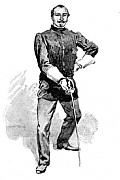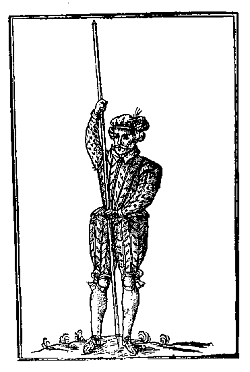English Martial Arts
Journal of Western Martial Art
May 2003
by Frank Docherty
And Caesar's spirit, ranging for revenge, Shall in these confines with a monarch's voice Cry 'Havoc,' and let slip the dogs of war.
Julius Caesar, III.i.
The English Martial Arts are a cultural legacy that the many of the English
people have let fall by the wayside. There are today, only a handful of
 practitioners that know the whole system of weapons and unarmed techniques of
the original Noble Science of Defence. But those few, are keeping alive part
of the English Culture, that allowed millions of English, in days gone by to
defeat their enemies, and to put justice and civilisation where there was
none.
practitioners that know the whole system of weapons and unarmed techniques of
the original Noble Science of Defence. But those few, are keeping alive part
of the English Culture, that allowed millions of English, in days gone by to
defeat their enemies, and to put justice and civilisation where there was
none.
Today, people everywhere are reaching out for the Martial Arts of other cultures, due I think to the many Kung Fu films that are in circulation, and maybe thinking that other aspects of these cultures are superior to their own. Forgetting that their own martial arts were often the skills that were used to subdue these other cultures. Now that statement may be politically inncorect, but the truth is the truth. England was in days of old well known for it's warriors, and fighting skills.
The English had at their disposal an extremely sophisticated martial arts system that was every bit as effective as those originating in the orient, and judging by the history of the English their martial skills were probably superior to those of these other cultures. The change came in the english martial arts, when ballistic warfare began to become more important than close quarter combat. However many traditional European martial arts survived, both for civilian self defence, and for the sporting arena, but a common place for them to go was the theatre, as in stage combat. although the stage combat of days gone by is far removed from what is seen on the stage and screen today. England today, by comparison with the England of say five hundred years ago, is a utopia, a fact noted by the Chronicler Holinshead who in 1586, wrote the following:
Seldom shall you see one of my countrymen above eighteen or twenty yeares old to go without a dagger at least at his backe or his side, although they are aged burgesses or magistrates of a citie, who in appearance are most exempt from brabbling and contention. our nobilitie weare commonly swords or rapiers with these daggers, as doth everie common serving man that followeth his lord and master...... Finallie no man travelleth by the waie without his sword or somesuch weapon except the minister, who commonly weareth none at all unlesse it is a dagger or a hanger at his side.
( Aylward, English Master of Arms...)
(excerpt taken from English Martial Arts by Terry Brown )
These statements clearly state that the majority of Englishmen, carried weapons, and had the right to do so, which dispells the myth that the common people were a helpless downtrodden section of society, and a few good historians , have failed to teach otherwise. In doing so they have overlooked one of the most potent forces in the development of English society and democracy the ever present threat of armed insurrection forced authority to show the population a respect and consideration that was rare elsewhere. something that is missing from government today. A century before Bhodidarma, Ammianus Marcellinus ( c. AD. 400 ) recorded that:
Almost all of the Gauls are of tall stature, fair and ruddy, terrible for the fierceness of their eyes, fond of quarrelling, and of overbearing insolence. In fact a whole band of foreigners will be unable to cope with one of them in a fight, if he calls in his wife, stronger than he by far and with flashing eyes; least of all when she swells her neck and gnashes her teeth, and poising her huge white arms, begins to rain blows mingled with kicks, like shots discharged by the twisted cords of a catapult.
The English martial arts offer a wide variety of weapons , and unarmed
techniques. The unarmed aspects of the noble science, offers a complete self
 defence system of unarmed combat. Now the majority of people still think of
bare knuckle boxing to be a crude and brutal art, practiced by thugs.
But in reality the bare fist fighting side of the art is a sophisticated
system of combat, that can stand on it's own as a fighting art. The
techniques include everything from closed fist techniques, open hand
techniques, elbow , and arm techniques. There are also kicking, sweeping, and
knee techniques. as well as headbutting. Grappling also plays a part in the
Bare fist fighting of the Noble science, the famous cross buttock, and flying
mare, are just two of the weapons from the grappling armoury, and there are
many more aspects to the bare fist side of the art, many of which have to be
seen.
defence system of unarmed combat. Now the majority of people still think of
bare knuckle boxing to be a crude and brutal art, practiced by thugs.
But in reality the bare fist fighting side of the art is a sophisticated
system of combat, that can stand on it's own as a fighting art. The
techniques include everything from closed fist techniques, open hand
techniques, elbow , and arm techniques. There are also kicking, sweeping, and
knee techniques. as well as headbutting. Grappling also plays a part in the
Bare fist fighting of the Noble science, the famous cross buttock, and flying
mare, are just two of the weapons from the grappling armoury, and there are
many more aspects to the bare fist side of the art, many of which have to be
seen.
The weapon Arts of the English system are numerous. from the broadsword, sword and dagger, sword and buckler, backsword, two hand sword, and bastard sword. Quarterstaff, numerous polearms, threshalls, and cudgells. But the main aspect of the art is the fighting spirit that the art and training gives the student. The fighting spirit that other Martial arts speak of is nothing compared to the fighting spirit given to the student of English martial arts, because the student is also training in an art that his own culture and ancestors produced, which gives the training another aspect altogether. A pride in ones own culture, English pride. The skill of fencing, or fighting with a sword, has been practiced in all parts of the world for many centuries. Men, and sometimes women, fought battles with many different types of swords. Some trained seriously for the deadly combat of the duel. After duels were forbidden by law, sport fencing remained popular. The English system of martial arts, is a science, a deadly science that teaches people to not only defend themselves, but also their community.
Some of the best descriptions of swordplay come to us from the Icelandic Sagas. for example the Eyrbyggja Saga gives us a graphic description of a fiercly fought battle between Steinthorr and his companions, and the sons of Thorbrand, who were trapped on a rock situated in a frozen river. ..They were a long time attacking the reef. And when they had been fighting for a long while, Thord Bligh took a run at the reef and tried to thrust his spear into Thorlief Cimbe, for he was ever the foremost of his company. The thrust fell on Thorlief's shield, but because Thord had put all of his strength into it, his foot gave on the slippery ice-flake, and he fell on his back and slid sprawling down off the reef. Thorlief Cimbe leapt after him to try to kill him before he could get to his feet. Freystien Bove also sprang after Thorlief : he had on his spiked shoes. StienThorr ran up and cast his shield over thord as Thorlief was cutting at him, and with the other hand he hewed at Thorleif Cimbe and cut off his leg below the knee; but as this came to pass, Freystein Bove thrust at Steinthorr, aiming at his belly; but when Steinthorr saw that he sprang up into the air and the thrust passed between his legs, and these three feats which have now been told he did all at the same time...... Although these skills seem incredible, the English Warrior was adept at all these and more, when you live your life for war, you become very good at it, with the continuous practice of the warrior arts from childhood, they become second nature, and unconcious reactions.
....Warfare is proper for a nobleman....
( Maxims I, line 83 )
Bibliography:
- Terry Brown, "English Martial Arts", Anglo-Saxon Books, December 1997
About the author: is an English Martial Arts practitioner with 18 years training in various martial arts and who is the Assistant Instructor to Ancient Maister Terry Brown in the English Martial Arts. His interest lies in theBroadsword, Backsword, Sword & Buckler, Sword & Dagger,Bastard Sword, Two Hand Sword, Quarterstaff, Bill Hook, Threshalls, Knife work based on Silvers System and Principles, and bare Fist Fighting. Mr. Docherty has a Shodan in Jodo ( Japanese Stick fighting ) a black sash in five animals kung fu, is a kickboxing Instuctor, and a shodan in Iai Jutsu.
Journal of Western Martial Art
May 2003
EJMAS Copyright © 2003 All Rights Reserved